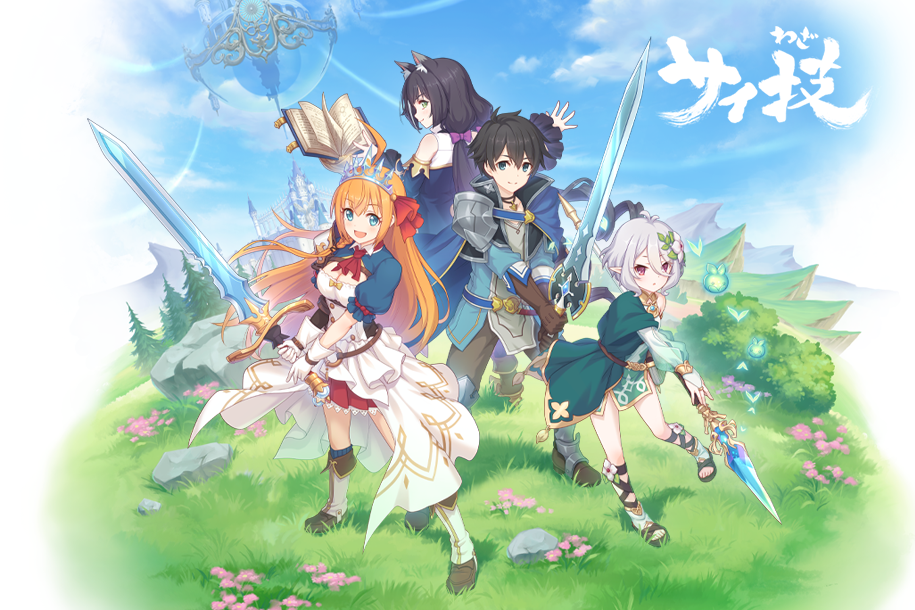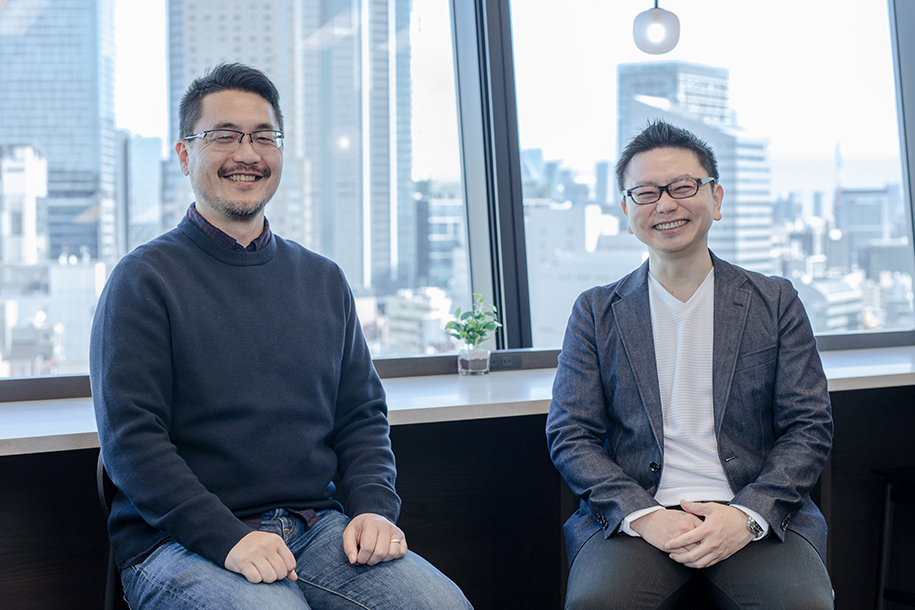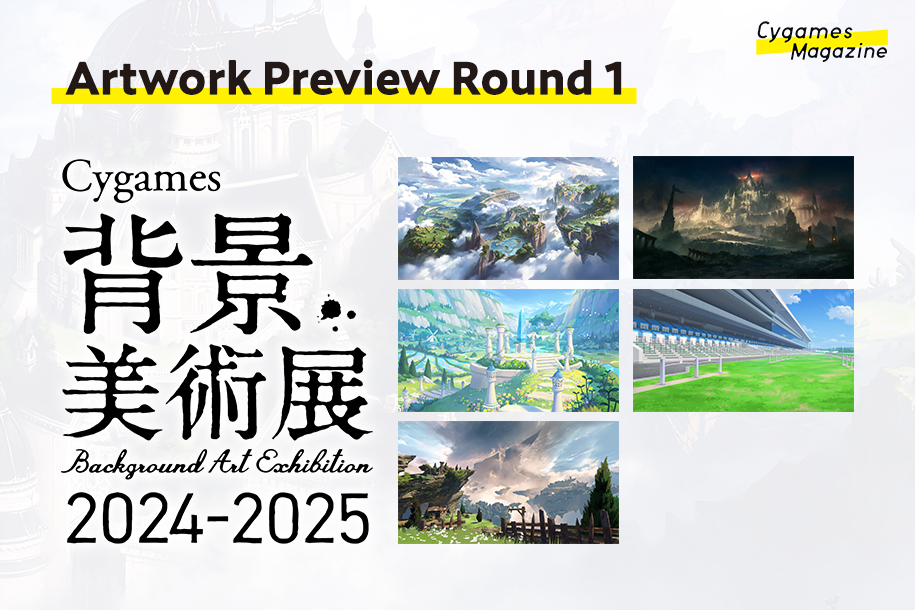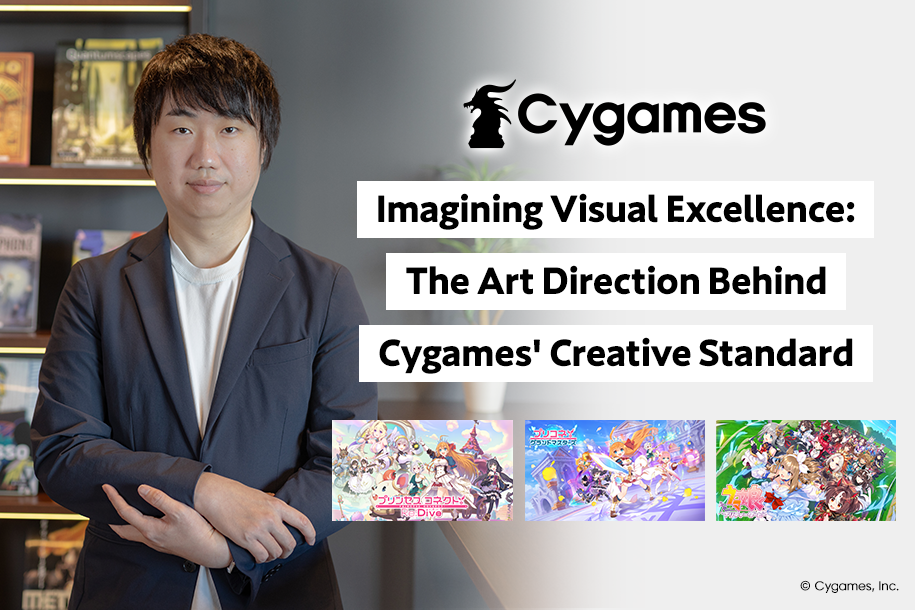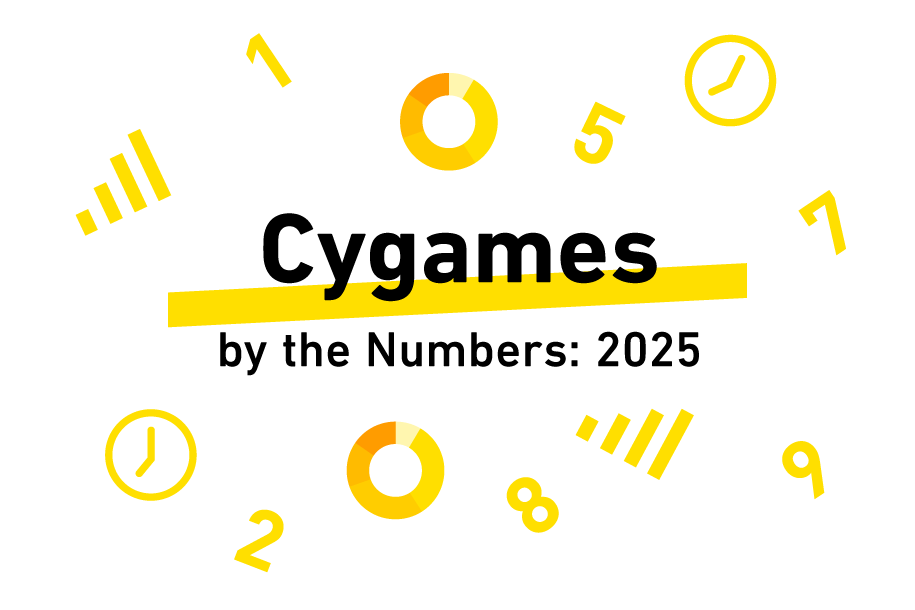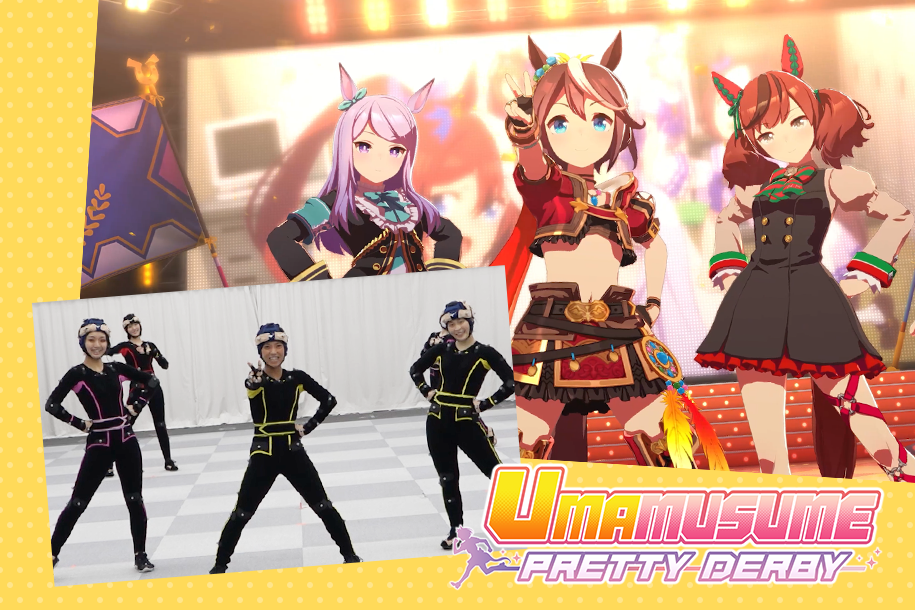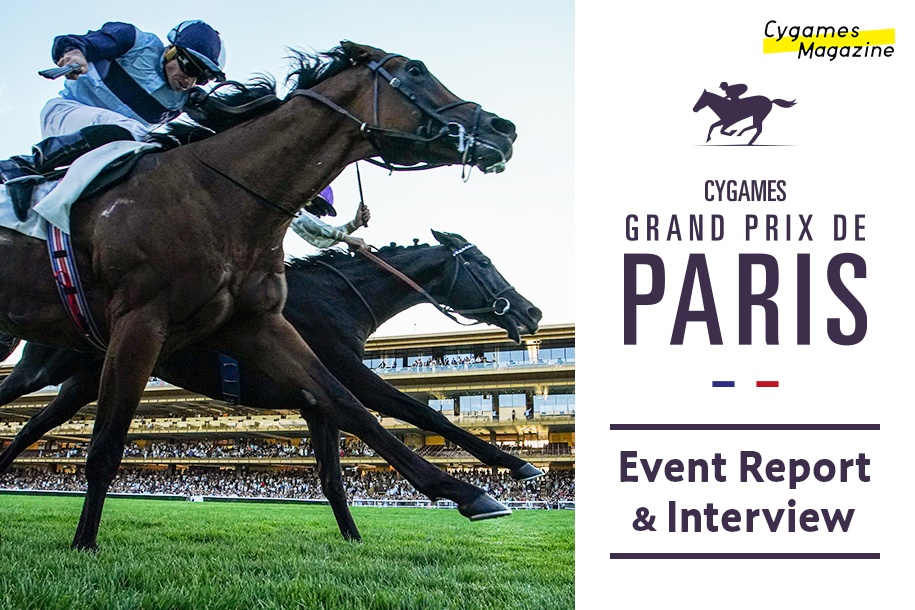Bringing the Skies to Life—Talking with the Engineers and Artists Behind the 3D World of Granblue Fantasy: Relink

Released in February 2024, Granblue Fantasy: Relink (“Relink“) is an ambitious action adventure game that challenged Cygames developers to recreate the illustrated 2D world of Granblue Fantasy (“Granblue“) in impactful 3D graphics. To achieve this, a team of environment artists and graphics engineers collaborated to bring the breathtaking skies, majestic clouds, and other environments of Granblue to life.
In this article, we talk to members of the team that helped build these environments and get a behind-the-scenes look at how the world of Granblue was recreated for Relink.
- Console Game Design Team
Assistant ManagerYasuaki
- Joined Cygames in 2018 after working at a game publisher. Lead on the Relink environments team.
- Console Game Design Team
CG ArtistSuguru
- Joined Cygames in 2020 with experience as an environment artist at a game developer. In charge of procedural modeling tool development, and sky and cloud visuals for cutscenes in Relink.
- Console Game Department – Cygames Osaka
Game EngineerDaiki
- Joined Cygames in 2016 after working at a game developer. Assisted with cloud and plant life art inspections before becoming the lead graphics engineer.
- Console Game Department – Cygames Osaka
Game EngineerKota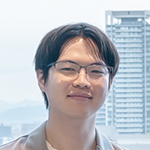
- Joined Cygames in 2016 as a new-graduate hire. A graphics engineer in charge of lighting-related graphics and post-processing.
Perfectly Recreating a Familiar World:
Crafting Granblue Fantasy’s environments for Relink in 3D
What are the defining elements of Relink’s environments and backgrounds?
Yasuaki: I would say it’s the rendering of the world of Granblue Fantasy in 3D graphics. During development, our goal was to recreate the beautiful setting of the original mobile game as faithfully as possible, and it took more than just transforming the 2D backgrounds into 3D environments. We challenged ourselves to bring everything—from design concepts to stage structure—over to Relink.
Suguru: For me, it’s the individual composition of the environments, and the soft colors that give them a hand-drawn quality. One aspect we were particular about when putting together these environments was designing them to fit naturally in their respective scenes. Rather than focusing on the realistic accuracy of colors or other objects, we were more concerned with each environment making the right impression.
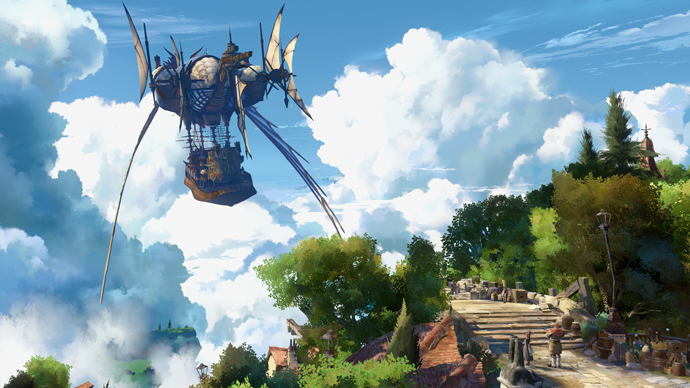
Daiki: From an engineering perspective, it’s become common practice to auto-generate large parts of the environment, but we found that automation just isn’t capable of faithfully recreating Granblue’s unique visual identity. Our artists took a hands-on approach to the environments and made meticulous adjustments to do justice to the world’s aesthetic, which I think can be seen in game.
Kota: Whether or not a design choice works in the real world, if it works in Granblue, we incorporated it—that was the thought process behind creating the game’s environments. For example, there are some instances in Relink where the lighting isn’t realistic, but we included it anyway because it better captured the signature Granblue look.
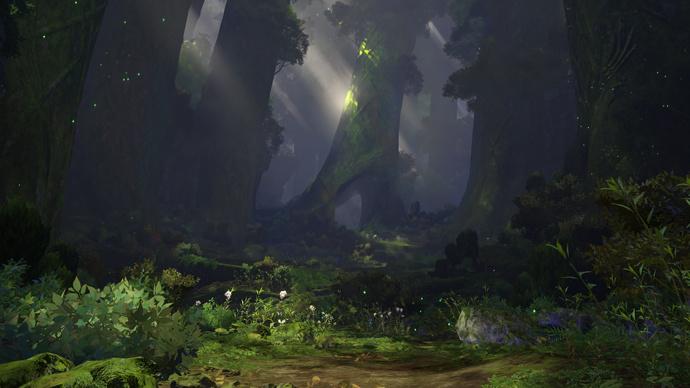
The attention given to the atmosphere and placement of objects is also a distinct aspect of Relink’s environments. Props are carefully integrated into the environment, and there’s a clear distinction between objects that are near and the ones that are far. It all comes together in a style that resembles a 2D illustration.
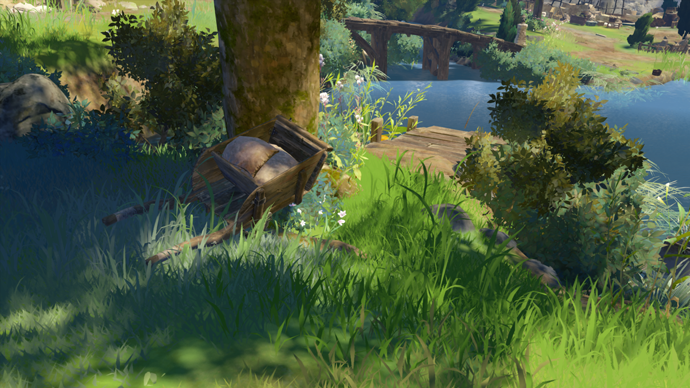
Can you explain the process of turning Granblue’s 2D illustrations into 3D environments for Relink?
Yasuaki: The production process had multiple patterns. Since Granblue is an established universe, we had a 2D artist prepare the backgrounds needed, then asked a CG artist to recreate it in 3D. Of course, due to the large number of 3D environments necessary and the time-consuming nature of this process, not every environment could be produced this way, so sections that the 2D artists were unable to create were completed by the 3DCG artists.
Suguru: CG artists would draw up a 2D background, get feedback from the art director on coloring, lore, and textures, make adjustments, then rinse and repeat. The back and forth helped us better understand the core concepts and artistic touch behind Granblue‘s environment design.
What is the role of the engineers in this process?
Daiki: Our job is to develop tools that enable the artists to realize their visions. When discussing Relink’s environments, the art director mentioned wanting a tool that 2D artists could use to draw in a 3D space. We anticipated our artists would have a lot of work to do as many aspects of recreating Granblue’s unique style couldn’t be automated. So we developed easy-to-use tools that would lighten their workload.
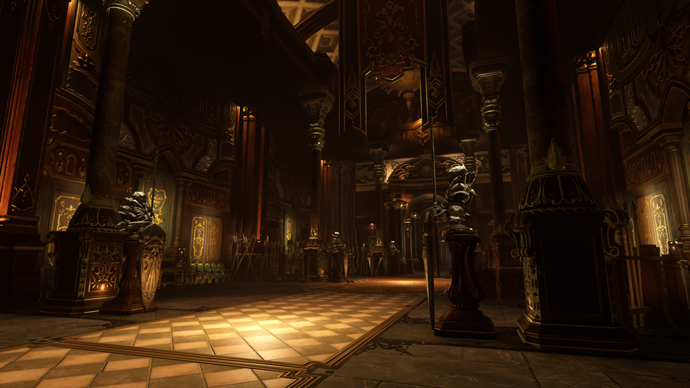
How did the artists and engineers cooperate with each other?
Daiki: Throughout the development process, we checked in with the artists and gathered their feedback on the direction and utility of the tool, then refined it based on their input. I remember Suguru’s clouds in particular taking a lot of time to get just right.
Kota: Primarily, I was responsible for lighting-related graphics, consultations about lighting, and organizing the workflow. Lighting involves a lot of non-engineering work, so linking up with artists and making sure I was on the same page as them was important for me. During our weekly meetings, I took requests and feedback from the artists about our tools, which helped guide our development.
As engineers, what were your main priorities when collaborating with the artists?
Daiki: To take what Kota said, getting on the same page as the artists was our top priority. Being engineers, our art knowledge is limited, so we relied on them to teach us the basics of Granblue’s artistic direction, such as what kind of visuals define the game’s style, and the reasoning behind certain color choices. That foundation helped us establish a common understanding and predict what features the artists might need in our tools.
Kota: We approached development with an open-door policy and made ourselves available to the artists for consultation. Whenever they contacted us, we’d share our progress with them. I think establishing trust in this manner was essential to the process.
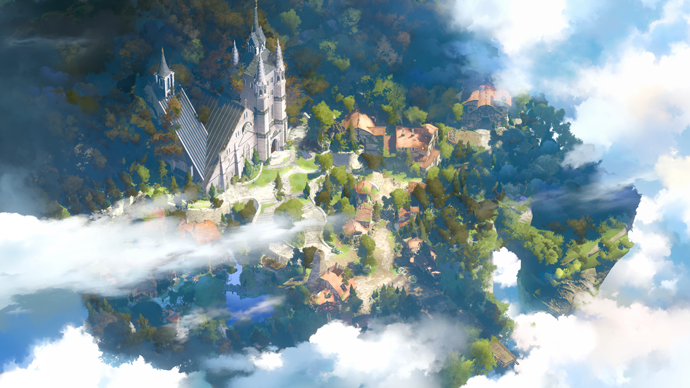
Depicting Clouds and Wind:
Understanding core characteristics to create visually appealing environments
What aspect of creating Relink’s environments were you particularly passionate about, and what kind of challenges did you face?
Suguru: Definitely the colors and on-screen composition of each environment, which I mentioned before. The characters that appear in Relink are just as colorful as our backgrounds, so achieving visual balance between them was crucial. One example of this can be found in how we adjusted the color of the sky to be more blue in scenes with Lyria, so the cyan of her hair will pop against the background. We made many similar adjustments to help the characters stand out.
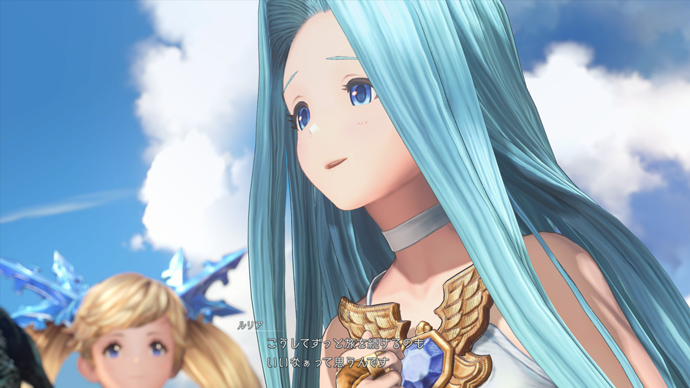
Kota: The primary focus for the engineers was maintaining the visual integrity of the game by ensuring the art remains largely intact. For instance, we were careful to engineer the environments to look as they’re supposed to even if the assets don’t load in time. We were also careful to make sure environments looked appropriate from every angle and that lighting didn’t get too bright or too dark out of nowhere.
As for your other question, I’d say optimizing performance was our biggest challenge. The downside about high-quality environments is that they have heavy processing loads, so we had to work with the artists to figure out how to improve performance without sacrificing quality.
Clouds are an important element in the setting of Granblue Fantasy. How did you go about recreating them for Relink?
Suguru: Our first priority when tackling the clouds was to understand their key features. Granblue’s clouds can be as large as mountains or as small as pebbles, and they change color depending on how the sunlight diffuses through the water and ice crystals within them. We took these characteristics into consideration when imagining clouds for Relink’s environments. Getting them to look natural in each scene was very difficult.
Daiki: We put considerable effort into inspecting and fine-tuning the clouds on the engineering side as well. It took a lot of trial and error to figure out the best way to render fluffy clouds in a 3D space and decide what kinds of clouds we needed in each part of the game. There are scenes that unfold across a full 360-degree view of the sky, so we tried matching clouds made by various methods, such as both polygon-based and 3D-modeled clouds, to different scenes. Ultimately, we narrowed it down to a few different approaches. I think Relink’s clouds were the most challenging and carefully crafted aspect of the environments.
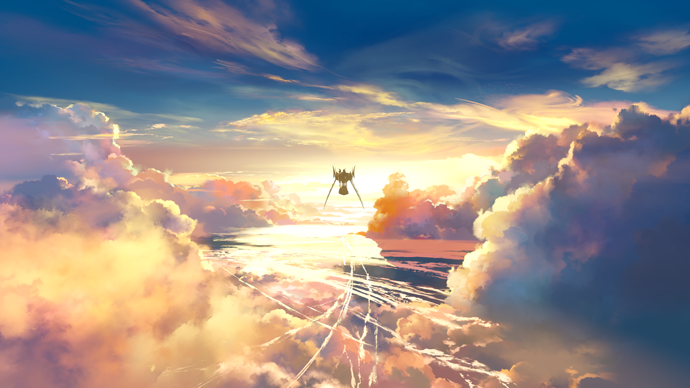
What other elements were you passionate about?
Yasuaki: Most definitely the wind. The engineers developed a “wind testing room” where we could test certain wind conditions. By lining up trees across the room and measuring their parameters, we were able to simulate different wind effect patterns for various situations. We configured the wind to respond to the peculiarities of each stage—blustering wind for stages on high ground, soft wind for stages with a lot of cover, and even more detailed settings in order to match the atmosphere of certain cutscenes.
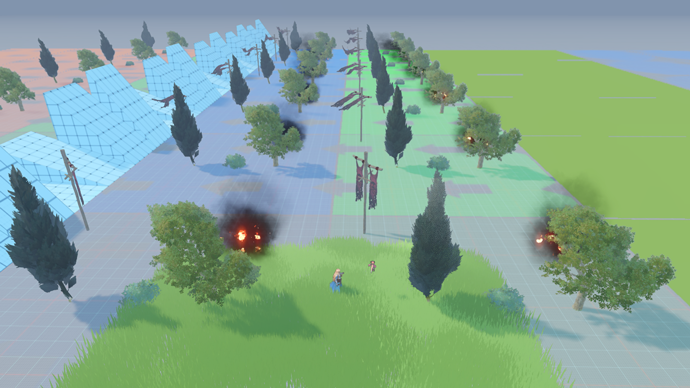
A Whole New Point of View!
Must-see environmental features as selected by the developers
Let’s discuss the elements that make up Relink’s environments—the skies, towns, flora, and other points of interest. Share with us some details about the notable features in each of these scenes.
■Skies and Clouds
Suguru: I think the opening movie and the shot of the Grandcypher flying that plays between stages are two scenes where our implementation of the sky and clouds stands out. The opening in particular we worked very hard on to get perfect, as it’s the first visual you see when you start the game, and it’s a scene based on concept art drawn by the art director.
As for the stage interlude scene, the only two elements are the Grandcypher and the sky, but what I’d like to note are that the clouds aren’t a looped visual. We designed distinct sequences to shift the atmosphere from when the ship first sets off to when the scene ends as a way to build up excitement for the coming stage.

■Towns
Yasuaki: There’s a great deal of contrast in Relink’s two main hubs, Folca and Seedhollow. These locations are vastly different from each other and offer plenty of notable visuals to discover. Folca was designed as a quaint, rural village with irregular structures that blend into the area’s natural surroundings. The historic city of Seedhollow, on the other hand, was imagined with modern planning in mind, and though its design is more linear, it still maintains a lived-in, residential atmosphere. I hope players enjoy the distinct features of these two locations.
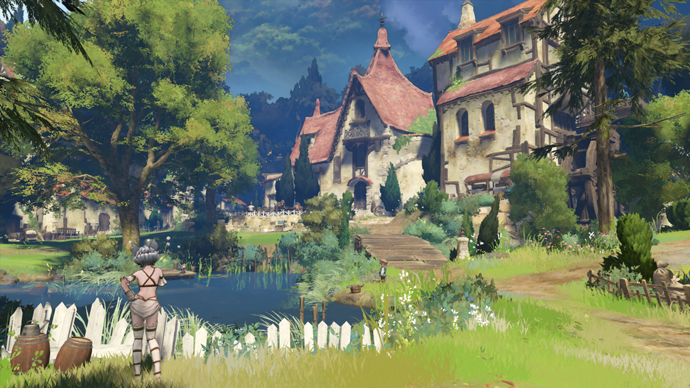
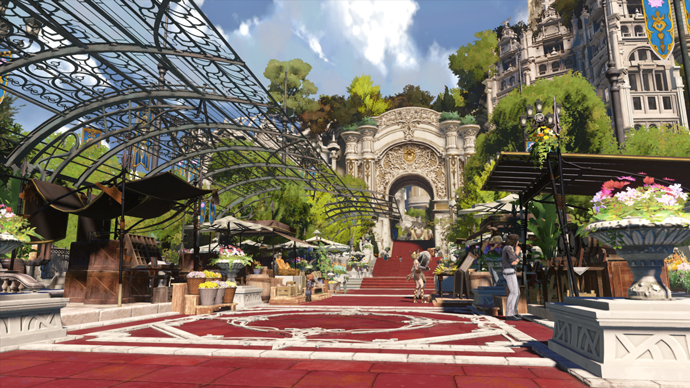
■Wind
Daiki: To make the wind visually apparent in outdoor stages, we developed a rippling animation to show movement in the grass, a technique our team refers to as “grass waves.” Rustling grass tells the player exactly how strong the wind is, affecting the overall atmosphere of a stage.
Kota: Here the grass at this character’s feet sways, but in the distance, the movement is more subtle. Even within the same stage we use various techniques to express wind movement, which we hope players have noticed.
■Plant Life
Suguru: In nature, plants vary in color and texture between species, and sometimes differences can be found between plants of the same species. We took this principle and combined it with Granblue’s signature aesthetic to create greenery for Relink.
Folca and Seedhollow are where I believe our plant designs stand out the most. The rich greenery in Folca blends in perfectly with the town’s atmosphere. While Seedhollow shares some basic elements with Folca, we also placed conifers and large-leafed plants to differentiate between the natural look of Folca and the manicured aesthetic of Seedhollow.
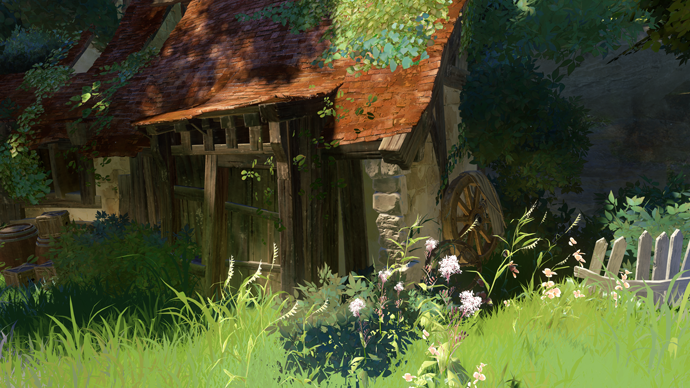
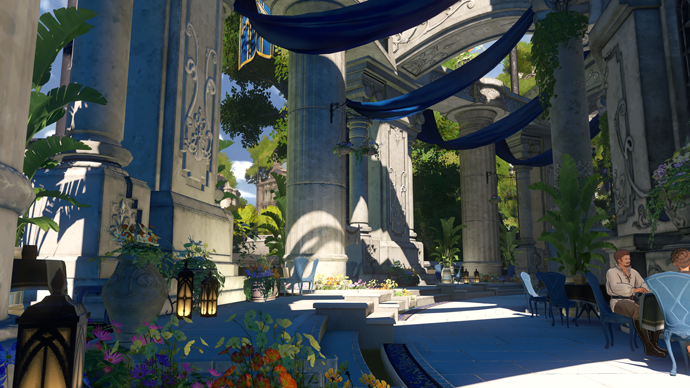
■Lighting
Kota: We put considerable thought into the lighting of the church players visit early on in Relink. We wanted the light to react with each item in the room in a way that would look pleasing from multiple angles.
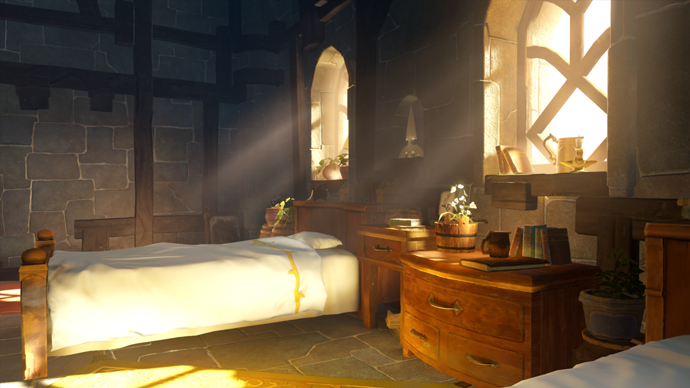
Another way we utilized lighting techniques is most apparent when looking at the ground in Seedhollow. In open areas like the square, shadows take on the blue hue of the sky, but in the backstreets, they’re more black. The lighting itself tells the player the mood of the area they’re exploring, which is something we think the players will find interesting.
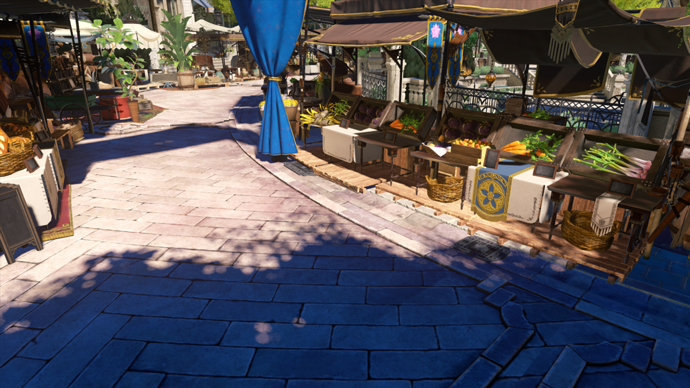
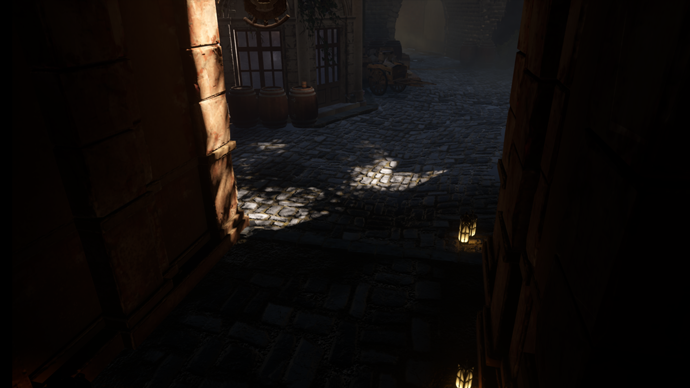
Are there any bits of hidden lore or secret design elements in the environments of Relink that you can share with us?
Suguru: Actually, there’s a few in the Folca church. The church’s reliefs and decorations are based on the design of Rolan’s outfit.
Yasuaki: I’ve got another one about the church. The reason why the church’s exterior is so different from its surroundings is because it was constructed by Astrals with advanced technology.
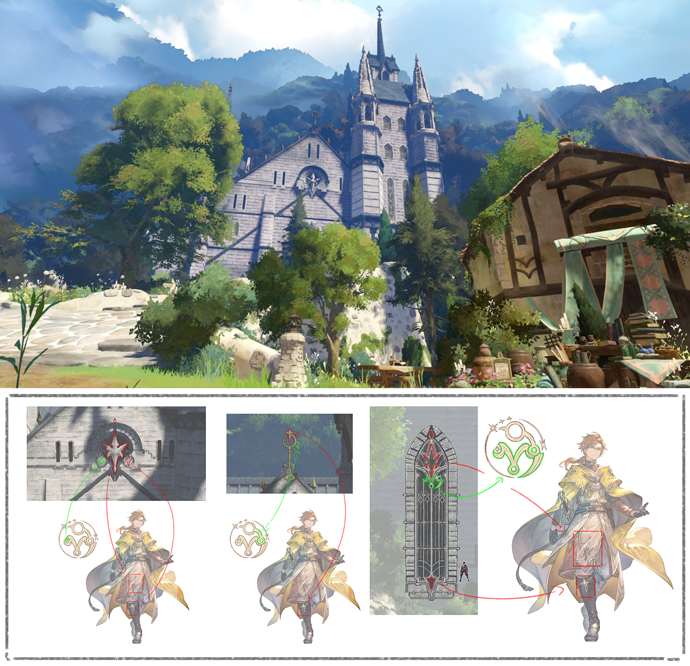
Suguru: For the scene that plays between stages, we added elements from the previous and upcoming stage that the players might notice. For example, when the party is headed to the snowy mountains of Leautagne Island, heavy-looking snow clouds emerge. Those same clouds appear again as they lift off to head to Seedhollow.
We added similar visuals when traveling to the deserts of Dahli Relicbelt, where the player can see the volcano of neighboring Phondam off in the distance, and for the voyage from Seedhollow to Vayoi, where the Pillar can be seen just as the scene ends.
Yasuaki: Speaking of, the reliefs in the Dahli Relicbelt stage drop hints at the types of enemies the player will be facing, and motifs inspired by the crew’s journey can be found in the Pillar of Vayoi. We encourage everyone to look for these details we planted throughout Relink.
Asking the Environments team:
What is the key to improving teamwork?
Relink’s environments were created with a high degree of cooperation between the artists and the engineers. What advice would you give to others looking to foster a similar relationship between different departments?
Daiki: We’ve mentioned this before, but making sure everyone is on the same page and showing each other respect are the keys to success. The tools we develop don’t mean much unless the artists actually use them in their creative process. Respecting their role and observing how they work enables us to create user-friendly tools that support their efforts.
Yasuaki: I think Daiki summed it up perfectly. Showing mutual respect and being careful not to overburden each other with excessive communication is also important. Developing a game successfully involves a lot of trial and error, so opening yourself up to efficient communication and establishing a relationship where ideas can be put to the test immediately is a good practice. With that in mind, I try to make myself as approachable and easy to talk to as possible.
Another point is to not be so defensive about your work. Game development often requires you to break the mold and do something different. Never use a busy schedule as an excuse to turn someone away. Achieving success is easier when you maintain a helpful attitude and are always ready to listen.
Lastly, for all of the aspiring environment artists and engineers out there, please share with us what you think makes your profession fulfilling.
Kota: The best part about being an engineer is that the tools you develop help facilitate the creation of something amazing. It’s incredibly exciting and fulfilling to see an artist’s creative output increase by bounds because of tools you’ve made.
Daiki: The most rewarding aspect is being able to collaborate with a team to accomplish something I couldn’t have done alone. I can’t draw in any dimension, yet I’m a graphics engineer for Relink’s environments. It’s the perfect career for anyone who wants achieve something extraordinary as a team.
Suguru: One of the most exciting things about working on game environments is that there is always a fresh discovery around the corner. I enjoy researching for a new project and looking at everyday objects from a different perspective. It’s humbling to find out how much I don’t know, and equally exciting to let myself explore novel techniques and unfamiliar realms. Collaborating with engineers in particular opened my eyes to new possibilities, and has allowed me to create things beyond my wildest imagination. It’s hard to overstate just how enjoyable my job is.
Yasuaki: Backgrounds and environments are elements that encompass the majority of the content we see on screens, not just in video games. The pressure is immense when you think about how much this single aspect dictates the setting and quality of any given project, but that makes the work all the more rewarding.
Backgrounds and environments are elements that encompass the majority of the content we see on screens, not just in video games. The pressure is immense when you think about how much this single aspect dictates the setting and quality of any given project, but that makes the work all the more rewarding.
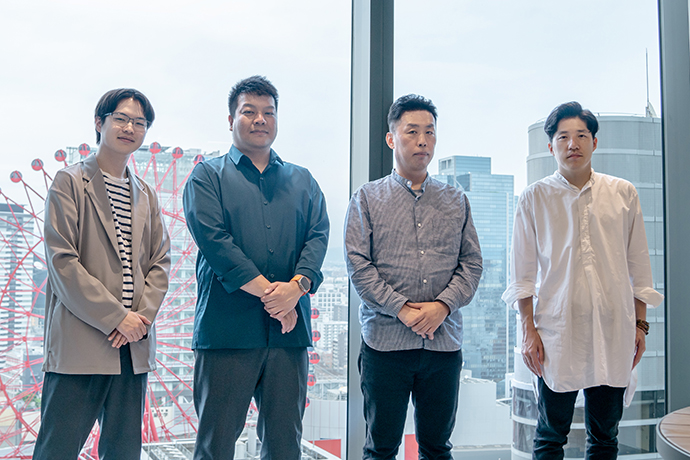
And that wraps up our behind-the-scenes look at how Relink’s stunning environments were made. Don’t forget the to take in the scenery the next time you pick up a title produced by Cygames!



